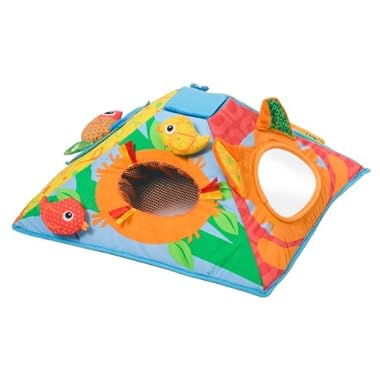Here are the top five moves you can begin as soon as your baby is born:
1. Tummy to Tummy~
a. Lie down on the floor or a bed, flat or propped up on pillows.
b. Place baby on your chest or tummy, so that you’re face-to-face.
c. Always hold firmly for safety.
2. Eye-Level Smile~
a. Get down level with your baby to encourage eye contact.
b. Roll up and place a blanket under the chest and upper arms for added support.
3. Lap Soothe~
a. Place your baby face-down across your lap to burp or soothe him.
b. A hand on your baby’s bottom will help steady and calm.
4. Tummy-Down Carry~
a. Slide one hand under the tummy and between the legs when carrying baby tummy down.
b. Nestle the baby close to your body.
5. Tummy Minute~
a. Place your baby on her tummy for one or two minutes every time you change her.
b. Start a few minutes at a time and try to work up to an hour a day in shorter intervals by the end of three months.
Don’t get discouraged every bit of tummy time makes a difference!
Now...the fun stuff! There are a lot of options and toys out there to help babies during tummy time. These are just a few that I've used and would recommend to families with little ones.
Boppy pillows are a GREAT beginning tool to help babies with tummy time. It's an easy way to prop your baby and give them the support they need to develop core muscles and their neck muscles to life their heads. These are great to use up until a year because they provide support for young ones learning to sit as well. I know many parents who have these laying around and they are great for helping your child develop.
Brilliant Basics Musical Tummy Fun Playmat
Recommended Age: Birth & Up
Cost: around $30
Infantino Tummy Time Activity Center
Recommended Age: 6 Months & Up
Cost: around $25
These are all great resources to help your baby with tummy time. They provide a stimulating and engaging means for your baby to interact while playing in this position. Many babies do not like to be on their tummies and will cry but it is THAT important that you keep trying and keep your baby on their belly. It really does make a difference and I hope that you will follow this advice and spread the word!
Next time I'm going to talk to you about some really great Cause-and-Effect Toys to help build cognitive skills along with fine motor and even gross motor skills.
Thanks! And until next time, Happy Playing!
~Amy
DISCLAIMER: All content provided on this blog is for informational purposes only. The owner of this blog makes no representations as to the accuracy or completeness of any information on this site or found by following any link on this site. The owner will not be liable for any errors or omissions in this information nor for the availability of this information. The owner will not be liable for any losses, injuries, or damages from the display or use of this information.













